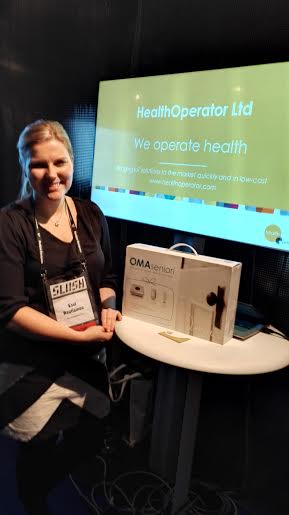Helsinki based Health Operator offers personalized diagnostics and monitoring services to the private health sectors as well as commercially to the public. They were one of the winners of this year’s Nokia Open Innovation Challenge, held at Slush 2015.
Imagine going to the bathroom to go about your daily routines, while an array of non-invasive sensors monitors your blood pressure, blood sugar levels, and heart rate. When some anomalous activity is detected, your physician is notified immediately, and you are contacted if needed.
A number of the technologies for this futuristic vision are already available, but as Health Operator’s Sales Manager Essi Rautianen points out, “The usage is very fragmented and it’s our goal to unify all these into one service product.”
An “all knowing” bathroom
The multi-sensor bathroom is an idea that has been floating around for a few years, and it’s what inspired Finland telecommunications veteran Riitta Tiuraniemi to found Health Operator (AKA Terveys Operaattori) in 2014. What makes the bathroom an ideal area for health monitoring is how closely regular bathroom rituals tie into your health. Eventually, sensors can even be installed that contain biomarkers for various diseases like cancer and diabetes.
While an “all-sensoring” bathroom is a bit further down the line, Health Operator’s first product, OMAseniori (website in Finnish) is a big step in non-invasive, in-home health monitoring.
OMAseniori incorporates motion sensor technology installed throughout the residence of a senior citizen, which uses an algorithm that learns the person’s regular routines. The sensors detect any unusual breaks from normal patterns of movement, such as getting out of bed bed at an unusual time (or not at all), or leaving the house in the middle of the night. Carers are contacted about any abnormalities, and by spring of 2016, Health Operator plans to launch a call center who will interpret which response is are best for detected disturbances – either doing nothing notifying a carer, or calling a doctor.
Combining new technology with elder care
OMAseniori aims to give independent living to the elderly while keeping carers and loved ones in the loop about the person’s whereabouts and movements. The sensors only need to be installed into the home, and then the person continues on with their daily life – there is nothing a user needs to wear or remember.
The world of elderly care is not known for being early-adapters of cutting-edge technology, and Health Operator has their work cut out for them convincing the carer community to shake up how care is given to the elderly. Rautiainen explains:
“There seems to be a bit of a trust issue that this is a reliable substitute for more traditional means of patient care and monitoring. This being said, the care community has been giving great feedback and are showing a willingness to incorporate our service to complement their existing program for the beginning at least.”
Besides building customer trust, health-tech perhaps more than any other sector must pass stringent guidelines to prove reliability and worth.
The Health Operator team is currently located in Helsinki in the fertile startup hub of the GE Health Village. As a starting point Health Operator is testing their product and business model in Finland, and has further plans to develop wireless non-invasive heart rate, fetal development, and blood sugar monitors.
Additional reporting by Lisa Mallner.
 Nordic Startup News Early Stage Startup News From The Nordics
Nordic Startup News Early Stage Startup News From The Nordics


